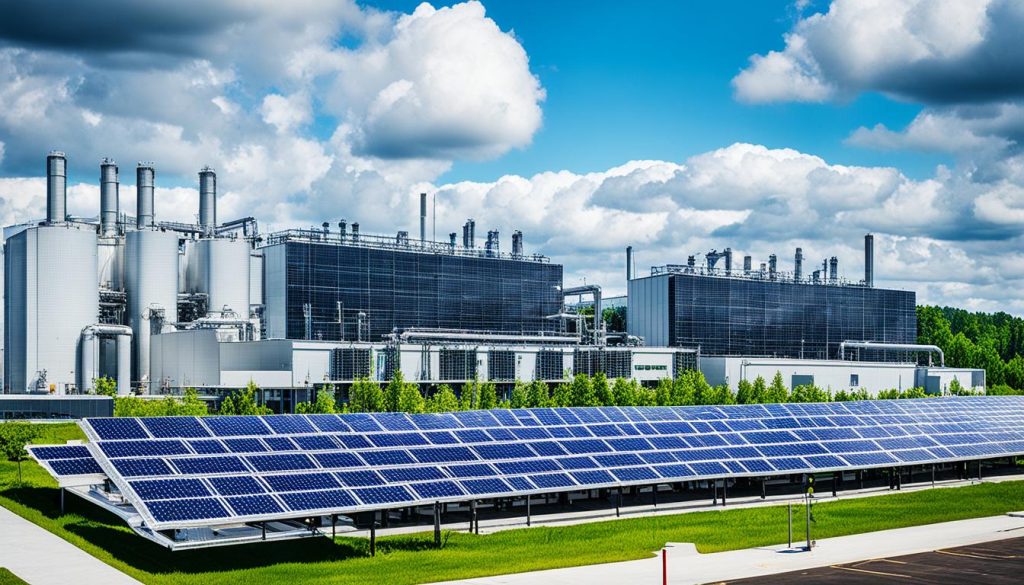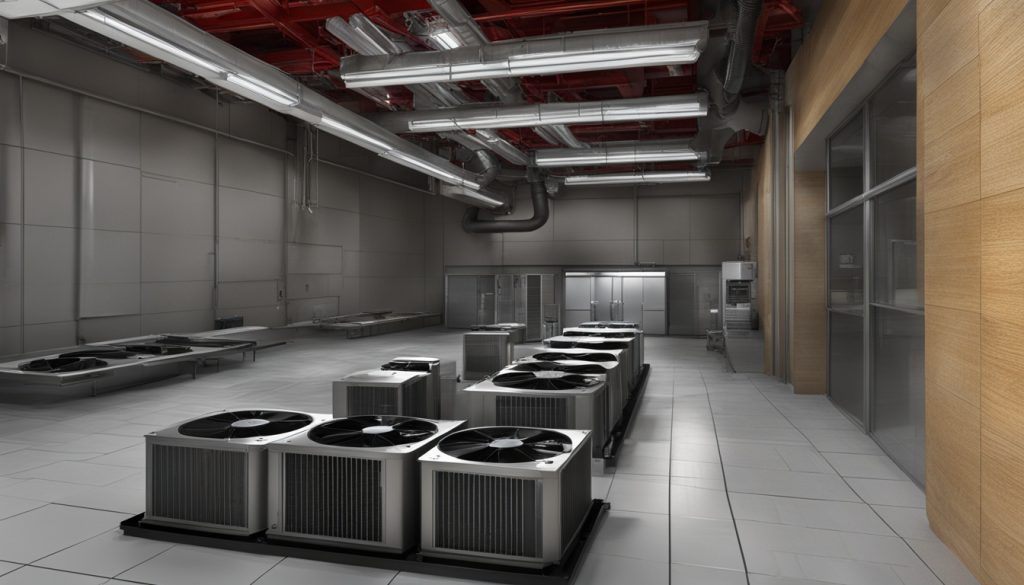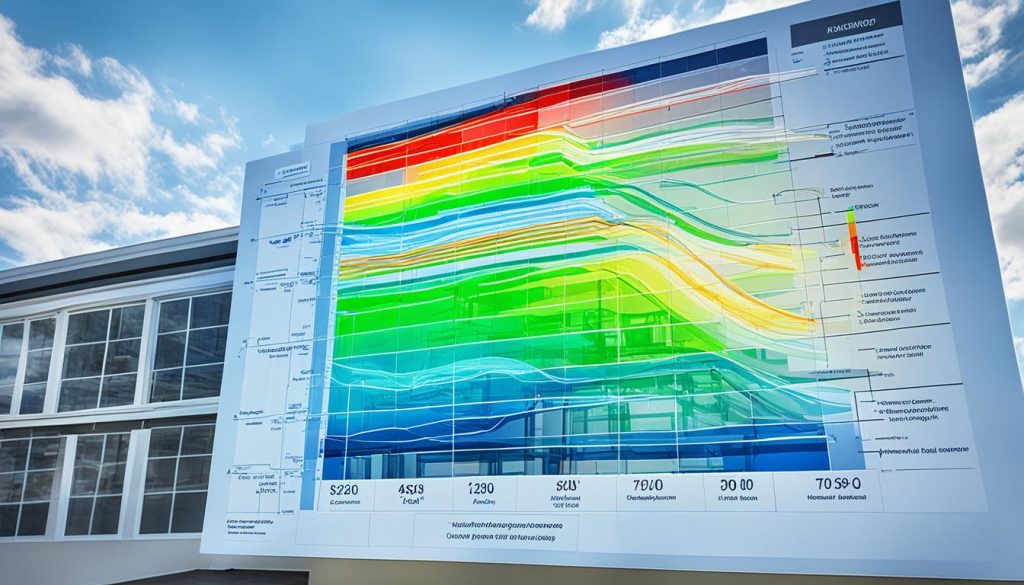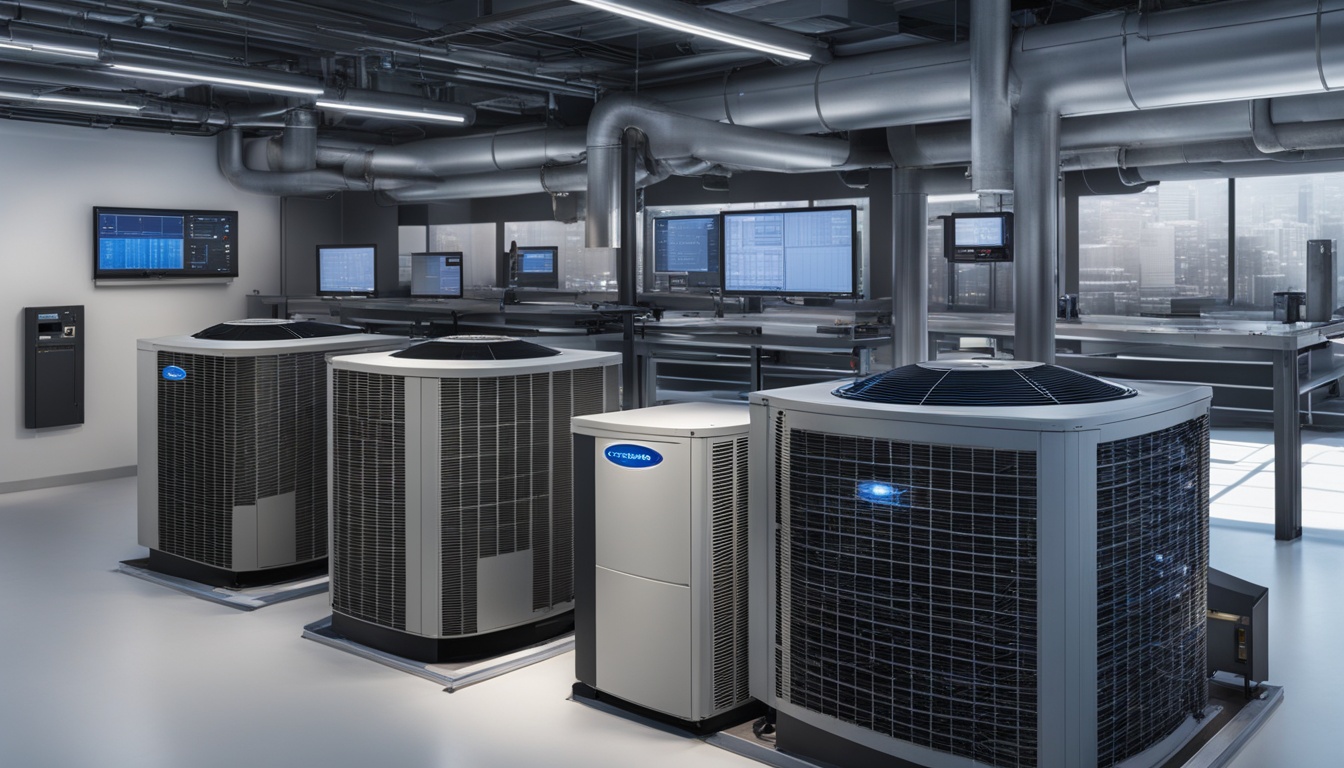The HVAC simulation guide helps make buildings more energy-efficient and green. It’s perfect if you want to create sustainable designs or get a LEED certification. This guide walks you through everything from setting up a project to doing the simulations. By using detailed building info and special software, you can improve homes and businesses.
Discover how virtual HVAC design and building energy simulation are key. You’ll learn tips and tricks that will make your HVAC system work better and have less impact on the environment.
Key Takeaways
- Understanding the intricacies of HVAC simulation for energy-efficient building design.
- Importance of gathering accurate building data for reliable modeling.
- Selection criteria for the best HVAC simulation software.
- The role of 3D models in effective HVAC system optimization.
- Critical parameters and control strategies for inputting HVAC system details.
- Incorporating local weather data to enhance simulation accuracy.
- Analyzing simulation results to identify energy-saving opportunities.
What is HVAC Simulation?
HVAC simulation is using computer models to guess how HVAC systems work in buildings. It’s key for in-depth HVAC performance analysis. This looks at heating, cooling, air quality, how much energy is used, and the system’s success overall. By virtually testing, we can make real systems use energy better and have less impact on the environment.
These tests are important for getting high LEED certifications and needing less energy. They help follow green building rules. With HVAC performance analysis, experts can guess how changes in design will affect energy use. This improves how energy-efficient buildings can be.
Using virtual testing HVAC systems can show if a system has problems before it’s built. Knowing this beforehand is crucial. It makes sure new HVAC systems are not just good enough but great. This leads to a cleaner and greener place for everyone.
Another good thing about HVAC simulation is testing different setups and plans to see what works best. This way, problems can be fixed early. This saves a lot of time and money compared to fixing things after the building is already up.
Using simulated models for HVAC performance analysis is important for homes and businesses. It shows a dedication to being green and making places use energy better. This helps the environment a lot in the long run.
Choosing the Right HVAC Simulation Software
Finding the best HVAC simulation software is key to accurately simulating building energy use. It boosts system performance and helps reach energy efficiency goals.
Popular Software Options
Common HVAC modeling tools include:
- EnergyPlus: Made by the US Department of Energy. It’s detailed and accurate.
- eQUEST: Works with DOE-2, easy to use with strong modeling.
- DesignBuilder: Simple to model with advanced simulation.
- OpenStudio: Integrates other tools, flexible and manages data well.
Key Features to Look For
When picking HVAC simulation software, think about several features. These are important:
- Compatibility with Project Scope: Make sure it fits your project, for homes or businesses.
- Comprehensive System Simulations: Tools should simulate all parts of systems in different conditions.
- User-Friendliness: Pick easy software to make simulations go smoothly.
- Support and Resources: Choose software with lots of help, tutorials, and a strong user community.
Choosing the right HVAC modeling tools means better simulations and easier system optimization.
Defining Your Project Scope
It’s key to set your project’s scope before exploring HVAC simulation details. Identify specific goals for the type of building you are focusing on. This step ensures your simulation work is focused and efficient. This is true for projects in factories, industrial sites, or homes. Being clear about these basics is vital for your project’s success.

Identify Building Type
Start by knowing what type of building you are working on. LEED Factory projects have different needs than commercial HVAC design or residential HVAC system analysis. Each building has its own features and requirements. Knowing these differences helps you make the simulation accurate. So, you can meet the building’s specific needs and goals.
Set Specific Objectives
Setting clear objectives is crucial for your HVAC simulation project. These objectives should aim at better energy use, lower impact on the environment, and meeting LEED standards. In commercial HVAC design, you might focus on better air quality and system efficiency. For residential HVAC system analysis, the aim could be to use less energy and make homes more comfortable. With clear goals, the simulation will move in the right direction.
Gathering Building Data for Accurate Modeling
To make a correct energy model, we need precise building data. This means we must collect many different kinds of data carefully. Checking data quality as we go is important. It helps make sure our model is trustworthy.
Essential Data Parameters
- Building Dimensions: We must measure the building’s height, width, and length accurately. This is key for our model to show real-life situations.
- Insulation Values: The insulation details for walls, roofs, and floors are needed. These help figure out how heat moves, affecting the building’s energy use.
- Window and Door Details: Knowing about the windows and doors is crucial for heat flow. It’s important for keeping the building warm or cool.
- HVAC Equipment Information: Important details about HVAC systems include their sizes and how well they work. Getting this right helps us model their impact correctly.
Ensuring Data Accuracy
Getting data right is a must for reliable results. Here are key steps to make data more accurate:
- Correct Building Orientation: It’s important to set the building’s orientation right. This helps us understand how much sun it gets and its energy use.
- Insulation Values Validation: Ensure the insulation details are current and accurate. This makes thermal calculations correct.
- Envelope Leakage Rates: Include precise data on how much air escapes the building’s envelope. This detail is needed for exact energy loss figures.
- Appliance and Lighting Loads: Knowing how much power appliances and lights use is essential. It completes our energy usage picture.
| Data Parameter | Importance |
|---|---|
| Building Dimensions | Provides basis for geometry and volume calculations in the model |
| Insulation Values | Determines the efficiency of the building envelope in retaining heat |
| Window and Door Details | Affects heat gain/loss and natural lighting simulations |
| HVAC Equipment Information | Critical for performance analysis of heating and cooling systems |
| Envelope Leakage Rates | Informs infiltration losses and overall energy consumption |
| Appliance and Lighting Loads | Key for representing internal gains and electrical load management |
Creating Detailed 3D Models
In the world of HVAC, making a detailed 3D model is crucial for accurate study. A thorough 3D building modeling setup shows the true size, shape, and direction of the building. It includes everything like walls, windows, doors, roofs, and shading parts. This makes the building model very realistic.
The precision of your 3D model affects the simulation’s results a lot. Every small part is carefully included. This way, you can predict how different designs will affect energy use and how well the system works.

But it’s not just about the building’s looks. Virtual HVAC design works hand in hand with the 3D model. It lets us fully check how the HVAC system fits the building in various designs. This helps adjust things for the best performance.
First, you need to get all the building details right:
- Measure the building accurately with site surveys.
- Use top-notch software to put these dimensions into a model.
- Add details like walls and floors to make the layout true.
- Include shades and other outside parts that change how warm or cool the building gets.
- Make sure the model can fit any HVAC system design.
With these steps, you make a 3D model ready for virtual HVAC design. This model lets you check current and “what-if” scenarios. It helps make wise choices for the best HVAC solutions.
With 3D building modeling, you can spot and solve problems before making the real system. This makes the design and setup phases go smoothly and be more effective.
| Aspect | Considerations |
|---|---|
| Building Dimensions | Accurate measurements of length, width, height |
| Materials | Types of insulation, construction materials, and windows |
| Orientation | Proper alignment with cardinal points for solar impact analysis |
| Shading | Incorporation of trees, awnings, and adjacent buildings for shadow mapping |
| Internal Layout | Room sizes, wall placements, and door locations |
| External Features | Details like patio covers, balconies, and external HVAC systems |
Making a detailed 3D model is key to a precise virtual HVAC design. This leads to better energy use and overall HVAC system performance.
Inputting HVAC System Parameters
Setting up your simulation model means putting in the HVAC system details. This is key for getting correct and dependable results. It lets you make smart choices and tweaks to the system. Here, we’ll look at what makes HVAC equipment work better.

Key System Attributes
To make your HVAC gear work best, you must put in the right info. This includes:
- Equipment types
- Efficiency ratings
- Capacity specifications
- Temperature and humidity setpoints
- Ventilation rates
Each detail affects how the simulation turns out. Getting these facts right makes the model act like the system in real life. This makes it easier to check how the HVAC will perform virtually.
Control Strategies
Good control strategies are key to efficient HVAC. Adding these to your model helps it run better. Popular methods include:
- Temperature control
- Humidity management
- Demand-controlled ventilation
- Energy recovery options
- Variable speed drives
Using these strategies in your model can show how your HVAC will do in different cases. This kind of testing helps you perfect your control methods. In the end, this means your HVAC works better overall.
Incorporating Weather Data
Adding weather data to HVAC simulations helps us predict how buildings will do. We focus on local weather data to make the predictions better.
Local weather sources like meteorological services or government databases are key. They help us get accurate information on things like temperature and humidity. This makes our simulations closer to real conditions, improving the predictions.
Local Weather Sources
It’s crucial to select reliable sources for local weather data. You can get this info from weather services, government databases, and groups like NOAA or Weather Underground. Getting accurate data on temperature, humidity, wind, and sunlight means our simulations match the real world better.
Seasonal Variations
Understanding how seasons affect HVAC systems is very important. Things like temperature changes and daylight hours really change how HVAC systems work. We must consider these to predict how systems deal with hot summers or cold winters.
Long-term climate changes are also important to think about. Using climate data from the past and projections for the future can help. This gives us insight into how climate changes might affect HVAC needs over time.
| Parameter | Data Source | Impact on HVAC |
|---|---|---|
| Temperature | NOAA, Weather Underground | Influences heating and cooling loads |
| Humidity | Local Meteorological Services | Affects indoor air quality and comfort levels |
| Solar Radiation | Government Climate Databases | Impacts cooling loads and daylight coverage |
| Wind Patterns | Climate Modeling Organizations | Can alter ventilation and heating needs |
Using local weather data, thinking about seasonal effects, and looking at long-term climate changes makes our simulations better. This detailed method ensures that the systems we design work well now and in the future.
Developing Occupancy and Usage Profiles
To make an HVAC simulation work well, we need detailed info on how a building is used. This means learning about when and how people are in the different parts of the building. Knowing this helps us figure out the right size for HVAC systems. It also makes these systems work better to keep people comfortable.

Occupancy Schedules
Occupancy schedules show us when and for how long each part of a building is being used. Knowing this is key because it affects how much heat the building puts off. This heat affects our HVAC calculations. When we know these schedules well, we can set up the HVAC system to work its best during the busiest times.
Equipment Load Profiles
Equipment load profiles look at how much energy different machines and devices use. Things like lights, computers, and kitchen appliances all add heat to the building. We need to include this in our calculations. Doing so helps the HVAC system run efficiently.]]>
Running HVAC Performance Simulations
When you run HVAC performance simulations, your hard work pays off. These simulations are key for a deep analysis. They let you see how energy is used in the system. You can check out different conditions. This includes the weather, how many people are there, and how well the equipment works.
Computational fluid dynamics HVAC simulations are great for this. They let you see how air moves and where the heat goes in the building. This view helps make the HVAC system better. That way, everyone stays comfortable and it uses less energy.
These models help find and fix issues. You can make the airflow better and the whole system work well. This is a big help for people designing and checking buildings. They want buildings that use less energy and work well for the people inside.
When looking at HVAC performance, you might ask:
- How does the HVAC system respond to extreme weather conditions?
- What are the most energy-efficient temperature settings?
- How does occupancy variation impact system performance?
- Can the system maintain optimal indoor air quality?
- What are the cost implications of different system configurations?
- How can the system be adjusted for peak energy savings?
Asking these questions helps you understand the system better. You learn where it can be better. With advanced simulation tools, you can tweak every part of the system. This makes the building use energy better and helps the environment.
Spending time on these simulations is very important. It makes sure the HVAC system works well and saves money. The things we learn help with new projects too. This way, we keep getting better at making HVAC systems work right.

Analyzing Simulation Results
Looking at simulation results is key to see how well HVAC systems work. It also helps to find places where we can do better. This is very important for making HVAC systems work their best and save energy.
Identify Areas for Improvement
One big goal when we look at the data is to find where we can fix the HVAC system. We might notice issues in the equipment, heat loss that’s more than we expect, or rooms not getting enough fresh air. Finding and working on these areas can make a big difference.
Energy-Saving Techniques
Using ways to save energy in HVAC design is crucial. These methods can cut down on how much energy we use. For example, we can upgrade equipment to be more efficient, add better insulation to buildings, or use natural ways to get light and air in spaces.
| Technique | Benefits |
|---|---|
| High-Efficiency HVAC Systems | Lower energy consumption and operational costs |
| Improved Insulation | Enhanced temperature regulation and reduced heat loss |
| Passive Design Strategies | Greater use of natural resources, reducing the dependency on mechanical systems |
Working on HVAC system optimization and using energy-saving in HVAC design helps a lot. It makes HVAC systems do better and use less energy. Plus, it makes buildings more green and fits with LEED and other green building ideas.
HVAC Simulation Guide
In this guide, we look at how building energy simulation helps make HVAC systems better. Knowing about virtual HVAC design can change how you look at energy use. It’s key for getting LEED certification and making HVAC systems work best in all kinds of buildings.
- How does HVAC simulation contribute to energy efficiency?
By carefully looking at how a building uses energy, HVAC simulation helps cut energy waste. This makes systems more efficient and earth-friendly. - What software is best for HVAC simulation?
Options like EnergyPlus, eQUEST, DesignBuilder, and OpenStudio are great. They each have features that fit different needs. - Why is accurate building data important in HVAC simulation?
Getting building data right, like its size and insulation, is key to reliable results. It helps build accurate 3D models and set up systems well. - What parameters are essential for virtual HVAC design?
Things like how well the system works, how it’s controlled, local weather, and how the building is used are really important. They shape how your simulation turns out. - How does local weather data integration affect HVAC simulations?
Adding local weather helps see how your HVAC system might perform year-round. It ensures your system can handle all kinds of weather well. - How can HVAC simulations aid in achieving LEED certification?
By using less energy and being kinder to the environment, HVAC simulations support getting LEED certification. It shows your building is green and sustainable. - What are the main steps in conducting an HVAC simulation?
There are a few important steps: decide what the project includes, get accurate building data, make 3D models, enter system details, and run tests. - How can I analyze the results of an HVAC simulation?
Looking at simulation data helps find ways to save energy. This leads to better HVAC system setups. - What role do occupancy and usage profiles play in HVAC simulations?
How the building is used affects how much heat it gains and its overall load. Knowing this helps make the system more accurate and efficient. - How important are control strategies in HVAC simulation?
Control strategies really matter. They decide how well the HVAC system works. Good controls are crucial for a top-notch system design.
This guide is here to help you understand and use HVAC simulation for better energy use and system operation. We provide everything you need to succeed in making HVAC systems work efficiently and effectively.
Conclusion
This guide shows you how to model HVAC systems for maximum energy efficiency. It uses computer simulations to reach green building goals and meet LEED standards.
We talked about several key steps. You need to clearly define your project and gather detailed information. With the right software and vivid 3D models, you’re all set to improve your system.
After running simulations, you’ll spot places to make your HVAC more efficient. This advice works for any type of building, helping you make your projects green and efficient.





0 Comments